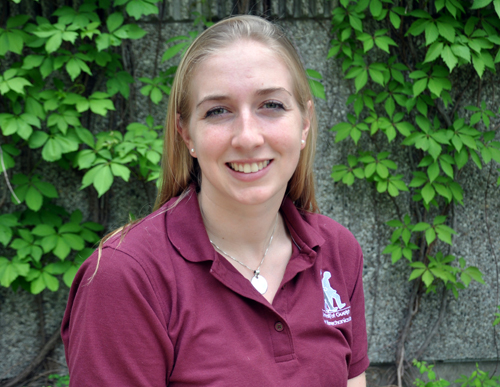
Most people don’t think much about how they walk, but for researchers in the University of Guelph Gait Biomechanics Lab, it’s all they think about.
Dorelle Hinton and Mike Bijman, both M.Sc. students in Human Health and Nutritional Sciences (HHNS), are looking at how people walk to better understand how we put one foot in front of the other.
In Hinton’s study, seven-year-old children are asked to balance a Frisbee in their non-dominant hand while reaching for a toy using their dominant hand. She is analyzing how they perform this task while seated, standing and walking compared to an adult control group.
“There’s a lot of background literature on major stages of development in children up until the age of seven,” she says. “We’re trying to pinpoint at this age what they can and can’t do in these walking and seated postures.”
By the age of seven, most children have developed adult motor skills, but Hinton has observed a “partitioning strategy” in which some children break certain tasks into smaller parts.
Her research aims to better understand how children move their bodies and whether they revert to more childlike motor skills. “That’s when we see children locking their body parts together,” she explains. “With younger children, when you ask them to do a task, they’ll actually lock their head and their trunk together as one to simplify the task.” This technique is known as en bloc.
Although most seven-year-olds are capable of moving their body parts independently, Hinton wants to find out if they use the en bloc technique when faced with a more challenging task.
“On top of the bimanual task, we add a cognitive task as well to see if their system gets overwhelmed, but so far we’re seeing some pretty accurate behaviours in children,” she says.
Participants are outfitted with sensors on their bodies and clothing to record their movement. The sensors emit infrared light, and a 3-D motion capture system records up to 100 pieces of data from each sensor per second. The researchers use the data to study factors such as acceleration, velocity and joint angles.
If you know a seven-year-old who is interested in participating, contact Hinton at dhinton@uoguelph.ca.

Bijman is looking at how people avoid obstacles while walking. In his study, participants wear goggles that temporarily block their vision as they walk toward an obstacle. He is currently looking at how athletes perform the task compared to non-athletes.
Participants can see the obstacle as they walk toward it until the computer-controlled goggles remotely block their vision for two strides. The obstacle consists of a wooden dowel placed horizontally across their path. “Sometimes with the vision loss they make contact with it,” he says, “but more often than not they cross over it.”
Bijman is interested in how their foot leaves the floor as they step over the obstacle and how high they raise their foot.
His lab partner, Josh Fisher, is studying the walking habits of older adults. Those subjects tend to reduce their walking speed as they approach the obstacle. “To avoid falling, you want to be more careful, so you slow down,” says Bijman. Older participants are not required to wear the vision-obstructing goggles.
With slower speed comes a loss of efficiency, he adds, because being careful takes extra time. “They take a little bit longer but they’re safe.” Older participants also tend to walk as close to the obstacle as possible before crossing over it – another sign of being cautious.
“The athletes take off from farther away because they’re less worried about stability,” says Bijman. As a soccer player, he decided to study other soccer players because of their superior leg control.
Having studied human kinetics for his undergrad at U of G, he says, “I’m very interested in vision in sports.”
Both students are supervised by HHNS professor Lori Vallis.